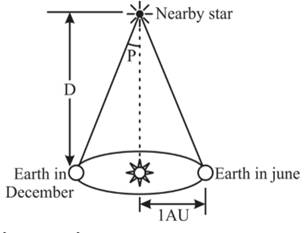
Concept explainers
Explain how parallax measurements can be used to determine distances to stars. Why can we not make accurate measurements of parallax beyond a certain distance?
Toexplain:
The way the distances to the stars can be determined by measuring the parallax angle.
The reason that the accurate measurements of parallax cannot be done beyond a certain distance.
Explanation of Solution
Introduction:
The changes or shifts in the position of a star, when it is being viewed from two dissimilar locations, is known as parallax. It is used to measure distances of the stars that are within a particular distance.
Distance of star is inversely proportional to the parallax.
i.e.
A triangle is formed between groundline, star and position at two different times,from two positions of Earth from the groundline. The ultimate angular distance between two positions gives an accurate parallax angle.
Thus, the total distance to a star is inverse in relation like above.
There is a procedure to find the distance to a star by using parallax in which

According to the figure,
Rearrange for D,
Conclusion:
As the distance between the star and the earth surface increases, there is a decrease inthe parallax angle as a result of which it is quite difficult to measure small angles.
Want to see more full solutions like this?
Chapter 19 Solutions
Astronomy
Additional Science Textbook Solutions
College Physics
An Introduction to Thermal Physics
Essential University Physics (3rd Edition)
Tutorials in Introductory Physics
Essential University Physics: Volume 2 (3rd Edition)
Sears And Zemansky's University Physics With Modern Physics
- What is the advantage of measuring a parallax distance to a star as compared to our other distance measuring methods?arrow_forwardYou measure a star to have a parallax angle of 0.12 arc-seconds What is the distance to this star in parsecs? 8.33 Hint: d = 1/p What is the parallax angle of a different star that is twice as far away as the star from the previous problems? [answer in arc-seconds without including the unit]arrow_forward1.)How long do you have to wait for a star to undergo its maximum parallactic displacement? 2.) How can the observation of stellar parallaxes in general be used as evidence against a geocentric view of the cosmos?arrow_forward
- the parallax angle of a star to be 0.002 arc-seconds. what would the distance be to this star?arrow_forwardStellar parallax is used as a tool to determine distances to stars. Describe how stellar parallax works. Also discuss the limiting factors in its use and the maximum distance that can be accurately measured using this technique. Do you believe this concept is unique to astronomy or used in other technical disciplines? Provide examples.arrow_forwardWhich of the following is a true statement? A smaller diameter star can never have a smaller number for its apparent magnitude than a larger star. Two stars with the same diameter and effective surface temperature will necessarily have the same absolute magnitude as well. Aristotle was the first person to detect stellar parallax. All G2 stars necessarily have the same absolute magnitude.arrow_forward
- Which of the following statements about stellar parallax is true? A. We observe all stars to exhibit at least a slight amount of parallax. B. Stellar parallax was first observed by ancient Greek astronomers. O C. The amount of parallax we see depends on how fast a star is moving relative to us. D. It takes at least 10 years of observation to measure a star's parallax. OE. The closer a star is to us, the more parallax it exhibits.arrow_forwardWhich star in the table of stellar data has the largest parallax? Star distance (pc) parallax angle (")| m M A 100 2 В 0.1 4 C 25 0.040 6 D 0.025 А. А О В. В O C.C O D.Darrow_forwardWe can use the parallax equation to determine the distances (in pc) to the stars. 1 dA = dA dB dB = = = arc seconds pc 1 arc seconds рсarrow_forward
- On Earth, the parallax angle measured for the star Procyon is 0.29 arcseconds. If you were to measure Procyon's parallax angle from Venus, what would the parallax angle be? (Note: Earth's orbital radius is larger than Venus's orbital radius.) A. more than 0.29 arcseconds O B. 0.29 arcseconds O C. less than 0.29 arcseconds D. zero arcseconds (no parallax)arrow_forwardA star has a parallax angle of 0.0270 arcseconds and an apparent magnitude of 4.641. What is the distance to this star? [Answer in parsecs] What is the absolute magnitude of this star? Is this star more or less luminous than the Sun? Answer "M" for More luminous or "L" for Less luminous. (HINT: the absolute magnitude of the Sun is 4.8) What is the luminosity of this star? (HINT: The luminosity of the Sun is 3.85×1026 W.)arrow_forward6. |A visual binary has a parallax 00 = 0.4 arcsec, a maximum separation a00 = 6.0 arcsec, and an orbital period P = 80 yr. What is the total mass of the binary system? Assume a circular orbit. [Hint: You need Kepler's Third Law of Planetary motion.]arrow_forward
 AstronomyPhysicsISBN:9781938168284Author:Andrew Fraknoi; David Morrison; Sidney C. WolffPublisher:OpenStax
AstronomyPhysicsISBN:9781938168284Author:Andrew Fraknoi; David Morrison; Sidney C. WolffPublisher:OpenStax Horizons: Exploring the Universe (MindTap Course ...PhysicsISBN:9781305960961Author:Michael A. Seeds, Dana BackmanPublisher:Cengage Learning
Horizons: Exploring the Universe (MindTap Course ...PhysicsISBN:9781305960961Author:Michael A. Seeds, Dana BackmanPublisher:Cengage Learning Stars and Galaxies (MindTap Course List)PhysicsISBN:9781337399944Author:Michael A. SeedsPublisher:Cengage Learning
Stars and Galaxies (MindTap Course List)PhysicsISBN:9781337399944Author:Michael A. SeedsPublisher:Cengage Learning Foundations of Astronomy (MindTap Course List)PhysicsISBN:9781337399920Author:Michael A. Seeds, Dana BackmanPublisher:Cengage Learning
Foundations of Astronomy (MindTap Course List)PhysicsISBN:9781337399920Author:Michael A. Seeds, Dana BackmanPublisher:Cengage Learning



